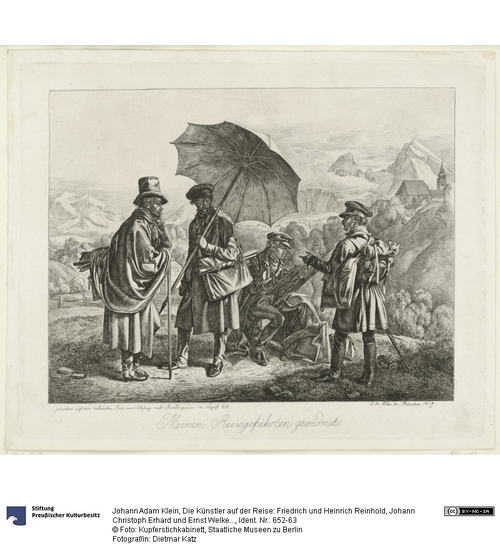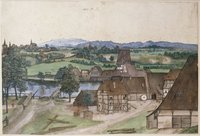Der Inschrift zufolge entstand die Vorlage für diese Graphik auf einer „malerischen Reise von Salzburg nach Berchtesgaden im August 1818“. Dargestellt und gewidmet ist das höchst subtil radierte Blatt den Künstlerfreunden Johann Adam Kleins, allesamt bedeutende Vertreter der süddeutschen Romantik und darüber hinaus typische Reisezeichner. In unterschiedlichen Konstellationen führte sie ihr Weg in beliebte Gegenden des frühen 19. Jahrhunderts, deren touristische wie künstlerische Entdeckung sie vorantrieben: an den Rhein, in die Alpen, ins Salzburger Land und nach Italien. Knotenpunkte der Karriere dieser Freunde waren die Kunstzentren Wien und Rom. Charakteristisch für die Zeit um 1800 ist, dass nicht mehr allein die Pilgerschaft in Gottes großer Welt oder die Sehenswürdigkeiten am Ziel der Reise interessierten, sondern häufig beiläufige Situationen unterwegs. Zur romantischen Weltsicht gehört, dass nicht nur der Gegenstand, sondern der Prozess des mobilen Zeichnens selbst reflektiert wird. So geht es bei der vorliegenden Darstellung um die Kommunikation der Künstlergruppe auf Reisen und natürlich den Akt des Zeichnens, hier demonstrativ mit dem Rücken zum malerischen Panorama der Alpenlandschaft.
Text: Hein-Th. Schulze Altcappenberg, in: Wir suchen das Weite. Reisebilder von Albrecht Dürer bis Olafur Eliasson im Kupferstichkabinett, hg. von Hein-Th. Schulze Altcappenberg und Ina Dinter, Berlin 2016, S. 40
According to the inscription, this print was based on a “picturesque trip from Salzburg to Berchtesgaden in August 1818.” This highly subtle etching is dedicated to Johann Adam Klein’s artist friends, all of them important figures in Southern German Romanticism and also typical traveling artists of the period. In various constellations, they made their way to the favorite regions of the early nineteenth century, advancing their touristic and artistic discovery: to the Rhine, the Alps, the Salzburg region, and to Italy. Vienna and Rome were key centers for the careers of these friends. It is characteristic for the time around 1800 that interest was no longer focused on a moral or spiritual pilgrimage or particular sights at the destination, but rather on the situations that took place along the way. An important aspect of the romantic worldview is that not just the object, but the making of mobile drawings is reflected upon. In this depiction, we are presented with an image of a communicating group of artists underway and the act of drawing itself, demonstrated by turning their backs to the picturesque panorama of the Alpine landscape.
Text: Hein-Th. Schulze Altcappenberg, in: We’re off then. Travel Pictures from Albrecht Dürer to Olafur Eliasson in the Kupferstichkabinett, published by Hein-Th. Schulze Altcappenberg and Ina Dinter, Berlin 2016, p. 40
en

